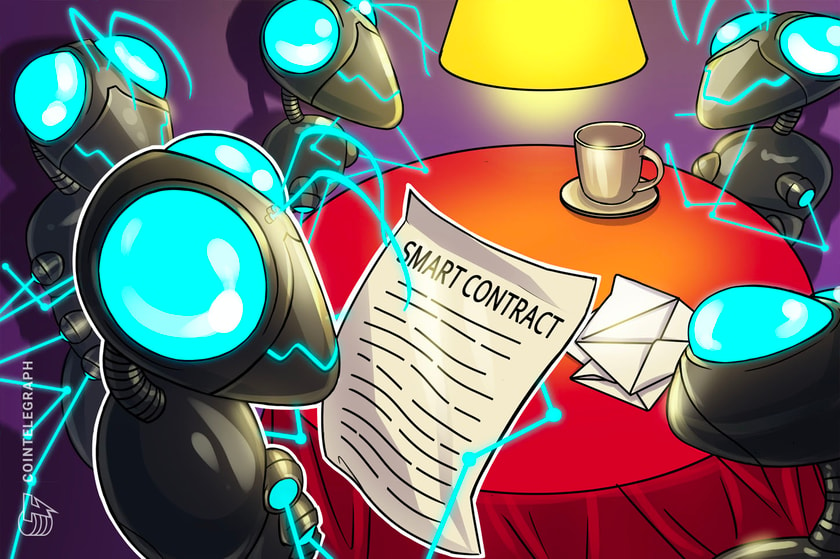 Citrea has launched its public testnet, creating a solution to allow Ethereum Virtual Machine (EVM) developers to access Bitcoin’s blockspace. The team believes this is testnet marks a significant step toward using Bitcoin as a settlement layer for decentralized applications (apps). Citrea Launches Testnet to Bring Decentralized Finance to Bitcoin Citrea‘s testnet is live on […]
Citrea has launched its public testnet, creating a solution to allow Ethereum Virtual Machine (EVM) developers to access Bitcoin’s blockspace. The team believes this is testnet marks a significant step toward using Bitcoin as a settlement layer for decentralized applications (apps). Citrea Launches Testnet to Bring Decentralized Finance to Bitcoin Citrea‘s testnet is live on […] On Aug. 15, 2024, the white paper for BitVM2 was published, outlining significant advancements in Bitcoin’s layer two (L2) capabilities. Building on the foundation laid by BitVM version 1, BitVM2 aims to bridge Bitcoin to second layers with improved scalability and security. New BitVM2 White Paper Introduces Advanced Solutions for Bitcoin L2 Scaling The original […]
On Aug. 15, 2024, the white paper for BitVM2 was published, outlining significant advancements in Bitcoin’s layer two (L2) capabilities. Building on the foundation laid by BitVM version 1, BitVM2 aims to bridge Bitcoin to second layers with improved scalability and security. New BitVM2 White Paper Introduces Advanced Solutions for Bitcoin L2 Scaling The original […]
Taproot Assets is “how we bitcoinize the dollar and the world’s financial assets,” says Ryan Gentry, director of business development at Lightning Labs.
Bitcoin layer-2 infrastructure firm Lightning Labs has released the mainnet alpha of Taproot Assets, a protocol aimed at enabling stablecoins and real-world assets to be issued on the Bitcoin and Lightning Network.
The current version, Taproot Assets v0.3, will provide a “feature-complete developer experience” to issue, manage and explore stablecoins and other assets on the Bitcoin blockchain, according to Ryan Gentry, head of business development at Lightning Labs.
“We believe this new era for Bitcoin will see a myriad of global currencies issued as Taproot Assets, and the world's foreign exchange transactions settled instantly over the Lightning Network.”
“With this release, developers can issue financial assets on-chain in a scalable manner,” Lightning Labs stated on Oct. 18 in a separate post. “Today marks a new era of multi-asset bitcoin.”
Announcing the first mainnet release of Taproot Assets , a protocol for assets on #bitcoin and Lightning.
— Lightning Labs⚡️ (@lightning) October 18, 2023
With this release, developers can issue financial assets on-chain in a scalable manner.
Today marks a new era of multi-asset bitcoin. https://t.co/2cNvZSvv8v
This version of Taproot Assets will work by routing through existing Bitcoin liquidity on the Lightning Network.
Gentry says the integration will extend Bitcoin’s network effects and move it one step closer toward “bitcoinizing the dollar.” He added:
“This is how we make bitcoin the global routing network for the internet of money. This is how we bitcoinize the dollar and the world's financial assets.”
Gentry described developer demand for stablecoin applications on Bitcoin as “overwhelming” — particularly given that some stablecoin issuers hold more United States Treasuries than the likes of Germany, South Korea.
The future we deserve#bitcoin https://t.co/XW433TVEIL
— Paolo Ardoino (@paoloardoino) October 18, 2023
“[It] signifies the importance of these assets globally, and gives a sense of scale for the global user demand,” Gentry added.
Related: BitVM wasn’t created to make Bitcoin a pseudo-Ethereum, says developer
Nearly 2,000 Taproot Assets were minted on testnets over the last several months in the lead up to the mainnet alpha launch, according to Gentry.
Alpha launches typically mean the development isn’t in its final state. Lightning Labs said the alpha tag indicates that they expect the community to test it for potential bugs.
Bitcoin Drivechains (through Bitcoin Improvement Proposal-300), Botanix Labs’ Spiderchain and the BitVM are among the other developments in the Bitcoin ecosystem looking to expand Bitcoin’s capabilities.
Magazine: Recursive inscriptions — Bitcoin ‘supercomputer’ and BTC DeFi coming soon

Building a decentralized exchange on Bitcoin would be a “step backward,” for example, said Bitcoin developer Super Testnet.
One of the developers working on “BitVM” — a Bitcoin-based virtual machine — reiterates the tech is intended to scale Bitcoin rather than launching Ethereum-like decentralized finance applications on the network.
BitVM’s whitepaper was released by ZeroSync’s project lead Robin Linus on Oct. 10 with technical support provided by pseudonymous developer “Super Testnet” — implementing BitVM’s first proof-of-concept and working on expanding BitVM’s capabilities.
Upon its release, some industry pundits formed the impression that BitVM would bring DeFi to Bitcoin like what the Ethereum Virtual Machine (EVM) did for Ethereum.
Lightning also fall short in the scaling department. It's nowhere near solving scalability.
— Hampus (@hampus_s) October 12, 2023
We need more complementary things.
> this is just another defi on bitcoin attempt.
Again, the motivation behind BitVM by the author was not DeFi. It was scaling.
However, Super Testnet tells Cointelegraph that BitVM is scaling-focused rather than being about implementing smart contracts and an avalanche of altcoins:
“The real killer app is scaling Bitcoin. [Robin Linus isn’t] a big fan of smart contracts. He's not a big fan of increasing Bitcoin's expressivity. He really is interested in making it so that Bitcoin can process millions of transactions per second.”
Super Testnet said he doesn’t want BitVM to be flooded with (EVM)-like tokens because it’ll bring bad actors to Bitcoin:
“I don't want to see everything from the Ethereum ecosystem because most of it is Ponzi schemes.”
Building a decentralized exchange on Bitcoin would be a “step backward,” he added.
Meanwhile, Super Testnet notes that BitVM won’t be an “instant death” for Ethereum’s altcoins, which some have suggested — though it could take demand away from them.
Hot Off the Press: BitVM White Paper Drops! Experience a groundbreaking computing approach for smart contracts on #Bitcoin
— RichQuack (@RichQuack) October 10, 2023
Unlock functionalities previously assumed to demand a soft fork with these enhanced smart contracts.
Could this be the end of #altcoins? pic.twitter.com/1GA43VE7If
The developer hopes that Bitcoin (BTC) essentially remains the only monetary unit on the Bitcoin network:
“A big property that makes Bitcoin important is maintaining one monetary asset that everyone can agree on instead of having floating exchange rates that are a burden for commerce,” he said.
Meanwhile, Super Testnet said BitVM’s intended payment infrastructure will also aim to improve one of the Lightning Network’s shortfalls — payment reliability.
“Lightning is wonderful as a system and it's much faster than probably anything we can make on Bitcoin. But one thing that Lightning doesn't do well is payment reliability.”
River, a Bitcoin-only exchange, revealed its Lightning payments success rate was 99.7% in August across 308,000 transactions.
He hopes BitVM can reach 60% of the transaction speed of the Lightning network.
BitVM: The 24 hour update.
— Bob Bodily, PhD | #BTC #ETH #ICP (@BobBodily) October 11, 2023
After thousands of Twitter posts and hours of spaces and discussions, we know much more about BitVM than we did yesterday. Here’s a quick update:
Excitement
1. BitVM is a new computing paradigm that leverages the universal gate NAND (along with other… pic.twitter.com/zBws7gOhjA
Related: Coinbase to integrate Bitcoin Lightning Network: CEO Brian Armstrong
The developer has also stressed that BitVM is optional like the Lightning Network and anyone will be able to transfer BTC or Bitcoin-assets out of the virtual machine back into cold storage or wherever they were beforehand.
“No one is forcing you to send your money into a virtual machine. If you want your money safe, keep it safe.”
Super Testnet also clarified a possible misunderstanding, explaining that BitVM, in its current state, cannot compute “anything” like its whitepaper suggests.
“We have to build more primitives in order to make it so that anything can run in it.” Implementing SHA-256 and encryption are some of the additions that need to be made, they noted.
However, Super Testnet revealed on Oct. 12 that BitVM is already processing basic functions:
Update: bitvm can perform *3* functions now and I'm in the middle of making a webpage where you can play with it pic.twitter.com/bXYOZKx2GV
— Super Testnet (@super_testnet) October 12, 2023
Linus and Super Testnet met at a Bitcoin conference around 18 months ago and have been working to scale Bitcoin at the scripting level almost ever since, he said.
Magazine: Should you ‘orange pill’ children? The case for Bitcoin kids books

The author of the white paper, Robin Linus, based BitVM’s architecture on Ethereum’s optimistic rollups with fraud proofs and recent Merkle tree developments.
A Bitcoin developer has proposed a new way to bring more expressive off-chain smart contracts to Bitcoin (BTC) without needing a soft fork.
Announced in an Oct.9 white paper titled “BitVM: Compute Anything on Bitcoin” by ZeroSync’s project lead Robin Linus, BitVM enables Turing-complete Bitcoin contracts without altering Bitcoin’s consensus rules.
"Any computable function can be verified on Bitcoin"https://t.co/Itf9UHos0C pic.twitter.com/CLQv49Ydsg
— яobin linus (@robin_linus) October 9, 2023
A Turing Complete system is one which can theoretically provide an answer to any computational problem.
With BitVM, the “logic” of Bitcoin contracts would be executed off-chain but verification would be made on Bitcoin — similar to Ethereum’s optimistic rollups.
BitVM’s architecture is based on fraud proofs and a challenge-response model where a “prover” can make claims and a “verifier” can perform a fraud-proof to punish the prover when false claims are made.
Linus explained that Bitcoin, in its current form, is limited to basic operations, such as signatures, timelocks, and hashlocks — but that can now be broadened with BitVM, which Linus says can compute a host of interesting applications.
“Potential applications include games like Chess, Go, or Poker, and particularly, verification of validity proofs in Bitcoin contracts.”
“Additionally, it might be possible to bridge BTC to foreign chains, build a prediction market, or emulate novel opcodes,” said Linus.
Linus said a limitation of the model is that it is limited to a two-party setting with a prover and a verifier and that a significant amount of off-chain computation and communication is needed to execute programs.
Linus said the next “milestone” is to fully implement the BitVM in addition to Tree++ — a high-level programming language to write and debug Bitcoin contracts.
BitVM is enabled by the Taproot soft fork which took place in November 2021.
Linus cited Ethereum research into optimistic rollups and a study on Merkle Trees in contributing to the eight-page white paper.
Prominent Bitcoiner Eric Wall posted on X (Twitter) that the concepts outlined in the BitVM white paper “check out” and is “cautiously excited” to see what real-world experiments stem from it.
Bitcoin analyst Dylan LeClair is also impressed with BitVM’s white paper. But Adam Back, a Bitcoin Core contributor suggested that people shouldn’t get too excited about the development just yet.
for people getting (over) excited, this is cool but effectively a generalization of a two-party game - it says right in the abstract - so it's a bit like Greg Maxwell's 2016 ZKP contingent payments implemented example https://t.co/OeHRsbFjud
— Adam Back (@adam3us) October 9, 2023
Related: BIP-300 biff: Debate reignites over years-old Bitcoin Drivechain proposal
One builder in the blockchain space, “dotta,” noted that there is already a proof-of-concept on GitHub.
Another X user, Sam Parker, attempted to resolve a common fear among Bitcoin maximalists by explaining that BitVM won’t force Bitcoin’s to be “locked” into these contracts.
“Finally, this is opt-in. If you don’t trust your coins being locked to some Turing complete contract (totally reasonable) then don’t lock them to a Turing complete smart contract. One of [the] beauties of the UTXO system is security sandboxing.”
Others, such as “psage” say BitVM adds to the list of things that will push Bitcoin’s price forward in the next bull market.
The bullish stuff around #Bitcoin is snowballing, lots of them controversial, nevertheless a few off my finger tips:
— psage (@perspiringsage) October 9, 2023
- BitVM
- Ordinals
- Multiple Pres Candidates talking about it
- ETF
- Halving
- Privacy improvements
- Exponential Hash Rate increase
- Countries mining
....
Cointelegraph contacted Linus for comment but did not receive an immediate response.
Magazine: Wolf Of All Streets worries about a world where Bitcoin hits $1M: Hall of Flame